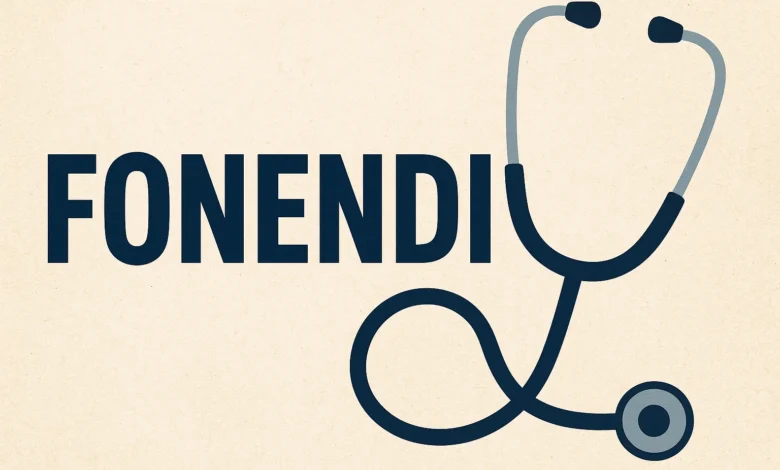
Fonendi: A Complete Guide to Its Meaning, Uses, and Importance
The word fonendi may sound unfamiliar to many people, but it carries a special importance in the world of medicine. In simple terms, fonendi is short for fonendoscope, which is another name for the stethoscope. Most people recognize the stethoscope as the tool that doctors wear around their necks to listen to the heart, lungs, and other internal sounds of the human body.
This article will explore the history, design, uses, and significance of fonendi, while keeping the explanation easy to understand. Whether you are a student, a patient, or just curious about medical instruments, this guide will give you a clear picture of what fonendi means and why it matters.
What is Fonendi?
Fonendi comes from the Greek words:
- “phōnē” meaning sound,
- “endein” meaning to give or transmit.
Together, the word suggests “giving sound” or “transmitting sound,” which explains its role perfectly. A fonendi is designed to transmit the internal sounds of the human body to the ears of the medical professional.
In everyday medical practice, the fonendi is essential for:
- Listening to heartbeat rhythms.
- Checking lung function.
- Identifying blood flow sounds.
- Monitoring bowel movements inside the abdomen.
History of Fonendi
The fonendi has an interesting origin. The very first version of the stethoscope was created in 1816 by René Laennec, a French physician. At that time, Laennec used a simple wooden tube to listen to a patient’s chest sounds.
- By the late 19th century, the simple tube design evolved into a binaural stethoscope with rubber tubing and two earpieces.
- Later, the term fonendoscope became popular in Europe, especially in countries like Italy, Russia, and Eastern Europe.
- Today, the terms stethoscope and fonendi are often used interchangeably.
Design and Structure of a Fonendi
A modern fonendi is designed with both simplicity and accuracy in mind. Its main parts include:
- Chestpiece – The round metal part placed on the patient’s body. It usually has two sides:
- Diaphragm: For high-pitched sounds like breathing and normal heartbeats.
- Bell: For low-pitched sounds such as abnormal heart murmurs.
- Tubing – Flexible rubber or plastic that carries the sound from the chestpiece to the earpieces.
- Headset/Earpieces – The two small tips that fit into the doctor’s ears to deliver the sound clearly.
The careful design of a fonendi allows doctors and nurses to amplify and filter body sounds that cannot be heard with the naked ear.
Uses of Fonendi in Medicine
The fonendi is not just a symbol of doctors; it is a practical diagnostic tool. Below are its major uses:
1. Cardiovascular System
Doctors use the fonendi to listen to:
- Heart rate and rhythm.
- Murmurs (abnormal heart sounds).
- Blood flow sounds in arteries and veins.
2. Respiratory System
Fonendi is used to detect:
- Wheezing (common in asthma).
- Crackles (seen in pneumonia).
- Reduced breath sounds (can mean lung collapse).
3. Digestive System
By placing the fonendi on the abdomen, doctors can hear:
- Bowel sounds.
- Absence of sound, which might mean blockage.
4. Blood Pressure Measurement
When combined with a sphygmomanometer (blood pressure cuff), the fonendi helps measure blood pressure by detecting Korotkoff sounds.
Types of Fonendi
Over the years, many versions of the fonendi have been developed:
- Acoustic Fonendi – The traditional and most common type, which relies on sound transmission through tubing.
- Electronic Fonendi – Amplifies sounds electronically and sometimes filters unwanted noise.
- Fetal Fonendi – A special type used by obstetricians to listen to fetal heartbeats during pregnancy.
- Digital Fonendi – Can record and even visualize sound waves on a screen for better analysis.
Advantages of Using a Fonendi
- Non-invasive: No need for surgery or blood tests to detect sounds.
- Quick and simple: Results are immediate.
- Portable: Lightweight and easy to carry.
- Cost-effective: Much cheaper than complex machines.
- Educational value: Medical students learn diagnostic skills through practice with a fonendi.
Limitations of Fonendi
While the fonendi is useful, it does have limitations:
- It depends on the experience of the listener.
- Background noise can interfere.
- Some internal problems cannot be diagnosed by sound alone.
- It cannot replace advanced tools like ECG, ultrasound, or MRI.
Fonendi in Modern Healthcare
Even with advanced machines, the fonendi remains a frontline tool in hospitals, clinics, and emergency care. For example:
- Paramedics use it in ambulances to quickly assess patients.
- Family doctors use it in routine check-ups.
- Specialists rely on it to confirm clinical findings before sending patients for expensive tests.
Caring for a Fonendi
To ensure accuracy and hygiene, proper care of the fonendi is essential:
- Clean the chestpiece with alcohol after each use.
- Replace worn-out earpieces regularly.
- Avoid leaving it in extreme heat or cold.
- Check tubing for cracks and leaks.
Fonendi as a Symbol of Medicine
Beyond its practical use, the fonendi has become an iconic symbol of the medical profession. It represents:
- Trust between doctors and patients.
- Knowledge and authority in healthcare.
- Compassion and care for human life.
Many medical logos and illustrations feature a stethoscope (or fonendi) around a doctor’s neck as a sign of dedication to health.
Future of Fonendi
Technology is changing the way the fonendi works:
- Smart fonendi with Bluetooth can connect to mobile apps.
- Sounds can be shared remotely for telemedicine.
- Artificial intelligence (AI) may help analyze sound patterns for faster diagnosis.
Despite these upgrades, the basic role of the fonendi remains the same—helping medical professionals listen to the body.
Conclusion
The fonendi is much more than a tool—it is a bridge between doctor and patient. From its invention in the 19th century to its role in modern medicine, it has saved countless lives by allowing doctors to hear the unseen world inside the body.
While technology continues to advance, the fonendi remains an irreplaceable companion in healthcare. For students, doctors, and patients alike, understanding its meaning, use, and importance deepens our respect for this simple but powerful medical device.


